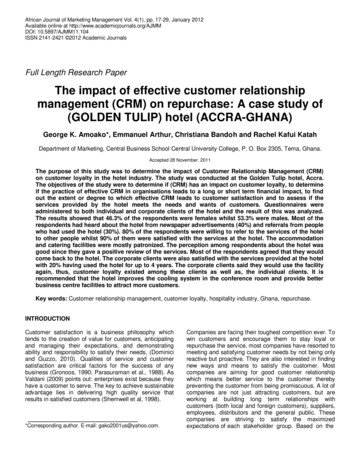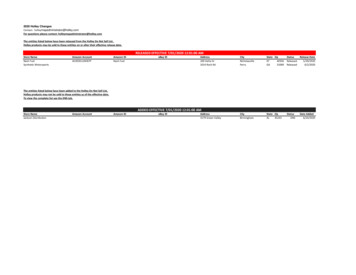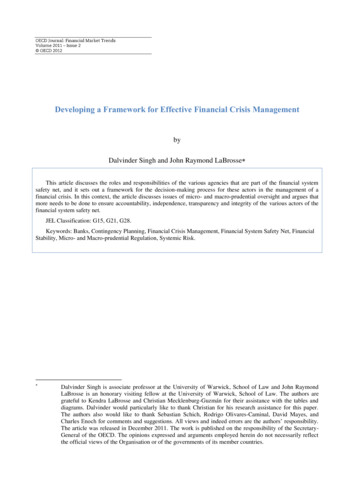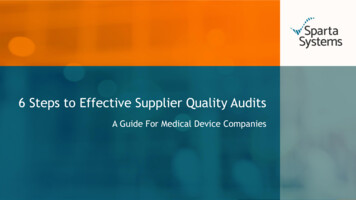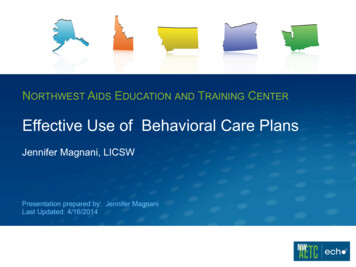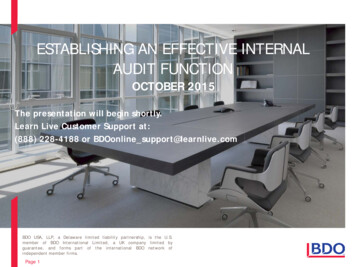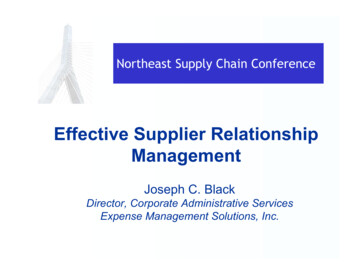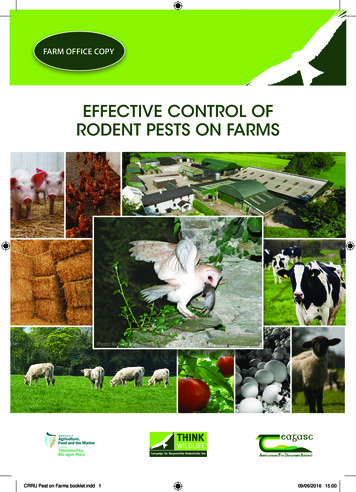
Transcription
FARM OFFICE COPYEFFECTIVE CONTROL OFRODENT PESTS ON FARMSPhoto: Richard MillsCRRU Pest on Farms booklet.indd 109/06/2016 15:00
Effective Control of Rodent Pests on FarmsINTRODUCTIONthought that 25% of farm fires are caused byrodents gnawing through electrical wiring.This booklet describes how rodent controlshould be carried out on farms in an effective,responsible and environmentally friendly manner.Rodent control is essential to ensure foodhygiene and for the protection of human andanimal health.A new approach to rodent control is neededwhich includes a range of actions, of whichrodenticides may be one, and this approach isdescribed in this booklet.The rodenticides in use today have a variety ofbrand names and most contain anticoagulantsubstances. Individual rodenticide productlabels provide details of the specific conditionsunder which each product must be used. Theseconditions reflect the detailed assessmentconducted by the Regulatory Authorities.There is a legal obligation to follow the labelinstructions.CURRENT PRACTICESIt is a false assumption that using tamperresistant bait boxes, particularly on a permanentbasis does not affect wildlife. Some of thecontamination of Irish wildlife is likely to be theresult of non-target small animals e.g. WoodMouse and Bank Vole, small birds, slugs and snailsentering bait boxes and feeding on bait. Equally,many predators in Ireland such as Barn Owls andRed Kites feed, to a large extent, on target rodentsand therefore may be exposed to rodenticidesthrough feeding on both target and non-targetsmall animals.Many farmers and other rodent control practitionersmay consider rodenticides as their primary, andonly means of control. However, rodenticides mustonly be used as a temporary solution and only afterother procedures have been fully considered andimplemented, and where farms and farm buildingshave been made less conducive to rodent infestation.RODENTS - ECONOMICS AND HEALTHRodent pests, whether Norway (Brown) Rator House Mouse, if not controlled, causeserious economic losses on farms through theconsumption, contamination and spoilageof food and feed, spread of pathogens whichare damaging to human and animal health,damage to buildings and equipment, loss ofpoultry and game birds, loss of quality assuranceaccreditation (Bord Bia, IGAS, etc.) and damage toreputation.A farm rodent control strategy must considerthe concept of “risk hierarchy” whereby the leastsevere methods, in terms of risk to humans andwildlife, must always be considered first. Thisbooklet will help to plan and implement effectiverodent control and result in a reduced risk ofaccidental exposure of humans and non-targetanimals.Best practice rodent control, as specified in thisbooklet and in the CRRU code, is a condition ofthe GLAS scheme and is an important element ofGLAS training.t If using rodenticides, information on theproduct label must be adhered to, whichincludes - application details, manner and areaof use, details of required restrictions, resistanceinformation, and risk and safety information.Rodents are prolific breeders. A female HouseMouse can produce up to 40 young in a year,while a female Brown Rat can produce up to 80young in a year. Mice become sexually mature at5 to 8 weeks while Rats become sexually matureat 3 to 5 months. It has been estimated that thetotal crop losses caused by rodents each yearcould feed 200 million people - equivalent toalmost 40% of the population of the EU. Rodentsalso carry a range of parasites and pathogenswhich can affect humans and animals includingWeil’s disease, Salmonellosis, Brucellosis. It ist *U JT JMMFHBM UP CBJU TJUFT PO B QFSNBOFOU CBTJT unless justified by means of a documentedrisk assessment - measures to make sites lessamenable to infestation must be implementedonce rodents have been controlled.t 'BSNFST NVTU CFDPNF CFUUFS BDRVBJOUFE XJUI the risks inherent with the use of rodenticides,especially when they are applied outdoors, andmust implement all appropriate risk mitigationmeasures.2CRRU Pest on Farms booklet.indd 209/06/2016 15:00
IMPLEMENTING A RODENT CONTROLSTRATEGYand its value as a habitat for wildlife, includingpollinators and rodent predators. Requiredvegetation or scrub clearance should be carriedout outside the nesting season (March to August).It is desirable to provide an open area of 20 metresor so around buildings, so that harbourage isremoved and predators can take rodents.All methods used for the removal of rodents,including the use of lethal or non-lethal trapsand the application of rodenticide baits, havethe potential to harm non-target animals andthe environment. Although these risks can bemitigated by following best practice, they cannotbe entirely avoided. Therefore, the appropriatestrategy when choosing methods for the controlof rodents is to employ methods that have theleast risk for non-target wildlife but which will beeffective in the control of target rodents. This is theconcept of “risk hierarchy”.It is best practice to adopt an Integrated PestManagement (IPM) approach to rodent pest control.All available control options should be considered(as detailed on pages 6-8). The use of rodenticidescannot be justified unless these control options areaddressed.Relying on rodenticides alone does notguarantee the successful elimination of rodents. Itis important that, following restriction of food andwater to rodents and the application of measuresto reduce rodent numbers, consideration begiven to ways of improving site management.This should provide effective long-term control ofrodent infestations and will rarely have significantimpacts on non-target animals. It is important toconcentrate particularly on improving hygieneand proofing, as well as maintenance and repairof buildings.WILDLIFE SPECIES AT RISK OF SECONDARYPOISONINGThe methods of managing our farmland impacton the wider ecosystem. Healthy environmentshave a rich variety of habitats that support andmaintain biodiversity. Predators sit at the top ofthe food chain and are sentinels of the health ofour environment. They play an essential role inmaintaining biodiversity and the balance of nature.Birds of prey and owls are top predators, as aremammals such as Pine Marten and Stoat. Ratsand mice form a major part of the diet of thesepredatory species.Rodent predators can be exposed to rodenticidesby feeding on rodents that have died ofrodenticides poisoning or by catching and feedingon live rodents which have these toxins in theirsystems. Recent Irish studies provided evidenceof rodenticides in the bodies of Barn Owls andRed Kites, likely acquired through consumption ofprey. The contamination of such species has beenconfirmed through analysis of carcasses as part ofongoing statutory monitoring and is a matter ofserious concern. Although species which feed onrodents are considered to be the most vulnerableto secondary poisoning, other species can alsobe contaminated indicating that these toxins areentering food chains through other routes.REMEMBER THAT:t " SBU DBO öU UISPVHI B HBQ UIF XJEUI PG B UIVNC (13 mm)!t " NPVTF DBO öU UISPVHI B HBQ UIF XJEUI PG B pencil (6 mm)!All necessary operations that make sites lessattractive to rodents should be implementedPROOFING AND EXCLUSIONAlthough they may be costly and requirefrequent maintenance, measures to prevent theentry of rodents into buildings (proofing) providea long-term solution to rodent problems and areusually without adverse impacts to non-targetwildlife. Proofing also needs to take accountof the presence of birds and bats and to avoidinterference with, or obstruction of, their nestsand roosts. Most wild birds, as well as their nestsand eggs, are protected under relevant NMENTAL CLEAN UPIn order to deter rodent infestations, farms should,as far as is practical, be regularly cleared of alldebris, rubbish, old machinery and equipment,unwanted stores of straw and hay, etc. Vegetationin the vicinity of buildings should only be removedhaving considered its potential to harbour rodentsImages and information on some of the birds andanimals that are at risk of secondary poisoning withrodenticides are provided on the following pages!3CRRU Pest on Farms booklet.indd 309/06/2016 15:00
Effective Control of Rodent Pests on FarmsBarn Owl (Scréachóg reilige)Barn Owls are scarce in Ireland – it is estimated that their population declined by over50% in the last 25 years, but are still present in every county. Although rare, they remainone of our best known birds, helped by the fact that in generations past they werevalued for catching rodents around farm yards. The Irish name for Barn Owl ‘Scréachógreilige’ (graveyard screecher) gives an indication of the nesting sites they use – churches,derelict buildings, ruined castles, and farm buildings. They are efficient predators,adapted to locate and catch small mammal prey. A pair can take up to 25 rodents ina single night during the breeding season. Their slow ‘moth-like’ flight is almost silent,which helps to conceal their presence.Concerns: Barn Owls feed predominantly on rodents and are therefore vulnerable toexposure to rodenticides in prey that have eaten rodenticides. Research indicates thatthe majority of Barn Owls are exposed to rodenticides.Photo: Richard MillsRed Kite (Préachán ceirteach)Red Kites were widespread until the end of the 18th century. Easily recognisable due totheir striking red colouration and distinctive forked red tail when seen in flight, they aremagnificent fliers capable of acrobatic flight and soaring for long periods. They were reintroduced to Ireland between 2007 and 2011 by the Golden Eagle Trust in partnershipwith the Welsh Kite Trust when 160 young kites were released in Co. Wicklow and Co.Dublin and have been breeding since 2009. There were 80 kites also reintroduced intoCo. Down between 2008 and 2010. They feed mostly on rodents, rabbits and crows, andalso on carrion including dead rats. Several Red Kite carcases have tested positive forrodenticides since their reintroduction.Concerns: Red Kites are at risk of secondary poisoning from rodenticides as theyinclude rats and other small mammals in their diet and will hunt live prey as well asscavenge dead animals and may be exposed through both routes.Photo: Tony CrossPine Marten (Cat Crainn)Once widespread throughout Ireland, by the 20th century only a few fragmentedpopulations remained in the west. More recently the Pine Marten population isrecovering. An adult Pine Marten is about the size of a domestic cat, hence the Irishname ‘Cat crainn’, and has a long tail that can be half the length of its body. Theyhave dark brown fur with a distinguishing creamy yellow throat patch. Pine Martensare arboreal, generally inhabiting forests but can be found in a range of farmlandhabitats. They are agile climbers, and are omnivorous taking both plants and animalsin their diet. In Ireland, they exploit a variety of resources including berries, fruits, smallmammals, invertebrates and birds.Concerns: Pine Martens have a varied diet but are at risk to exposure to rodenticidesthrough the live prey they take, in particular small mammals.Photo: Noel MarryBuzzard (Clamhán)Buzzards are present throughout Ireland and can be observed soaring over rich farmlandin lowland areas, particularly in parts of the east and south. They are a medium sized birdof prey with broad wings and a compact body. Buzzards became extinct in Ireland in theearly part of the 20th century but re-colonised naturally in the 1970’s. They hunt smallmammals such as rats and mice as well as rabbits, young Rooks, Magpies and HoodedCrows. They also take carrion, putting them at risk of feeding on rodents which have died asa consequence of rodenticide use.Concerns: Buzzards are considered to be particularly at risk of secondary poisoning fromrodenticides as they include rats and other small mammals in their diet and will hunt liveprey and scavenge dead animals and may be exposed through both routes.Photo: Shay Connolly4CRRU Pest on Farms booklet.indd 409/06/2016 15:00
Long-eared Owl (Ceann cait)Although rarely seen, this is the most common owl in Ireland. It is more often heard,particularly when there are young which call from the nest site throughout the nightduring the nesting season. Their call has been described as being like a squeaky gate.The ‘ear tufts’ from which their name derives are distinctive, as are their orange eyes.They nest in the disused nests of the Hooded (grey) Crow or Magpie in shelter belts,forests, hedgerows or isolated trees and hunt the surrounding countryside for smallmammals including Mice, Rats, Shrews, Bank Voles where available and also smallbirds. Like Barn Owls, they are vulnerable to secondary poisoning from rodenticides.Concerns: Long–eared Owls have a similar diet to Barn Owls and do not typicallyscavenge. They are susceptible to secondary poisoning from catching and feeding ona range of small mammal prey.Photo: Breffni MartinKestrel (Pocaire gaoithe)The Kestrel is one of our most common birds of prey. It has a distinctive huntingmethod - it hovers in mid-air, hanging almost motionless, scanning the ground forQSFZ *U NBJOMZ UBLFT TNBMM NBNNBMT o 3BUT .JDF 4ISFXT #BOL 7PMFT BT XFMM BT 'SPHT Lizards and small birds. It occupies a wide range of farmland habitats. It nests in trees,buildings, quarries and coastal cliffs. Recent survey work has shown a decline in theIrish Kestrel population. Although the extent of secondary poisoning of Kestrels inIreland is not known, research in the UK has confirmed that the majority of the Kestrelpopulation there are exposed.Concerns: Kestrels have a varied diet but small mammals are generally the mostimportant prey items and through this route they are likely to be exposed torodenticides.Photo: Clive TimmonsIrish Stoat (Easóg)Photo: Dermot BreenPeregrine Falcon (Fabhcún gorm)The Stoat, our smallest carnivore, is often mistakenly referred to as a Weasel to which itis closely related but which is absent from Ireland. The Irish Stoat, a native sub-species,is smaller with darker fur than Stoats elsewhere in Europe. They have reddish brown furwith a white underbelly and long, slender bodies about one foot in length with shortlegs and a tail with a distinctive black tip. They are widespread throughout Ireland anduse a range of habitats particularly stone walls, hedgerows, ditches, open woodlandand rocky scrub covered areas. They are a formidable predator, with excellent eyesight, smell and hearing, and actively stalk and chase prey. They can mesmerise othercreatures with outlandish behaviour and will hunt animals five times their own weight.Their diet includes rabbits, rodents, birds, eggs, and invertebrates, but they will also eatfruit and berries depending on availability.Concerns: Stoats have a varied diet but are at risk to exposure to rodenticidesthrough the live prey they take, in particular small mammals.0OF PG *SFMBOE T NPTU NBHOJöDFOU CJSET BGUFS TFWFSF EFDMJOFT UIF 1FSFHSJOF 'BMDPO IBT now returned to much of its former range and can be found throughout the country.It nests on cliff faces, crags, within quarries and even occasionally on building ledgesand church steeples including those in city centres. In winter Peregrines can be foundat estuaries, marshes and other expanses of open land.Concerns: Although Peregrine Falcons specialise on birds and do not typicallyfeed on small mammals, they can still be vulnerable to secondary poisoning whenrodenticides enter the lower levels of the food chain (e.g.slugs and snails), andcontaminate birds on which they feed.Photo: Neil O’ Reilly5CRRU Pest on Farms booklet.indd 509/06/2016 15:00
Effective Control of Rodent Pests on FarmsKEY POINTS IN RODENT INTEGRATED PESTMANAGEMENTt 3FDPSE FWJEFODF PG QPPS IPVTFLFFQJOH BOE hygiene, alternative food sources and water - allof which should be noted on the site plan.t "TTFTT BOE SFDPSE SJTLT MJLFMZ UP BSJTF GPS operators, employees and others by treatmentand arrangements to minimise risks arising.t "TTFTT BOE SFDPSE SJTLT MJLFMZ UP BSJTF GPS OPO target species that may be present in or frequentthe farm, and steps required to minimize thoserisks.Why?Rodents must be controlled because of risks tohuman and animal health; contamination andspoiling of food and feed; structural damage;Quality Assurance Scheme compliance; and loss ofreputation etc.How?Integrated Pest Management (IPM)t 1SPPöOH CVJMEJOHTt 3FTUSJDUJOH GPPE BOE XBUFSt 4VSWFZJOH BOE NBQQJOH UIF GBSNt POUSPMMJOH BOZ FYJTUJOH SPEFOU QPQVMBUJPOT t 5BLJOH NFBTVSFT UP SFEVDF MJLFMJIPPE PG SF infestation.t 3FEVDJOH UIF DIBODFT PG SF JOGFTUBUJPO CZ POgoing monitoringDESTRUCTION METHODSBiological Controls:'BSN DBUT BOE EPHT BSF NPSF FòFDUJWF JO QSFWFOUJOH the re-establishment of a rodent pest infestationthan in eliminating an infestation as they are betterable to catch and kill an invading rodent that doesnot know any escape routes. Cats are effectivepredators of mice, but usually will not attack anadult rat.Exclusion:Trapping:t 3FQBJS CVJMEJOH PS ESBJO EFGFDUT CSPLFO QJQFT defective sewer chamber covers, bad brick work,damaged cladding).t 4FBM HBQT VOEFS BOE BU TJEFT PG FOUSBODF EPPST and windows. BUT, if infestation is present, avoidextensive disturbance until control is achieved.t 8IFO QSPPöOH UBLF DBSF OPU UP JOUFSGFSF XJUI PS block access to nesting birds and bat roosts.Lethal and Non-lethal traps must be used inaccordance with relevant legislation and the CRRUBest Practice Requirements.Lethal Traps:A risk assessment must be completed prior to useof lethal traps. Based on the outcome of the riskassessment, break-back traps must be placed inareas where they cannot be accidentally triggered,and where the general public do not have access.Break-back trap locations should be recorded onsite plans/maps. Baited traps must contain a suitableattractant (e.g. chocolate, peanut butter or otherattractant) as the use of toxic bait in traps presentsunacceptable environmental risks.Restriction:Deny access to food, water and harbourage.t &OTVSF UIBU BMM BWBJMBCMF TPVSDFT PG GPPE BOE water for rodents are removed or contained.Survey & Map:t *OTQFDU BOE SFDPSE BMM GVSUIFS BSFBT GPS FYDMVTJPO and restriction.t *OTQFDU BOE SFDPSE UIF UZQF MFWFM BOE FYUFOU PG rodent infestation.t *G JOGFTUBUJPO JT QSFTFOU EP OPU EJTUVSC UIF TJUF until control has been achieved.t "TTFTT BOE SFDPSE EFHSFF PG QVCMJD BDDFTT BOE presence of children.t "TTFTT BOE SFDPSE QSFTFODF QPUFOUJBM QSFTFODF of non-target animals - pets, farm livestock, andwildlife. The presence of certain wildlife thatuse the farm may not always be obvious e.g.nocturnal species such as Barn Owls.Non-lethal Traps:Non-target animals caught in traps must bereleased unharmed back into the environment.Target rodents, Grey Squirrels and Mink must bedispatched humanely. Dispose of target animal6CRRU Pest on Farms booklet.indd 609/06/2016 15:00
carcasses with site domestic waste, in the site’snormal non-hazardous waste or by burying to adepth of at least 50 cm and away from sensitiveareas, water courses etc.The use of alphachloralose is illegal except for thecontrol of Mice indoorsAnticoagulantst 'JSTU HFOFSBUJPO BOUJDPBHVMBOU SPEFOUJDJEFT where available, include the compounds,warfarin, chlorophacinone and coumatetralyl,are less toxic and less persistent in animaltissues than second generation compounds,but larger quantities over longer periods withmore frequent checking are required to achievecontrol.t 4FDPOE HFOFSBUJPO BOUJDPBHVMBOUT CSPEJGBDPVN bromadiolone, difethialone, difenacoum andflocoumafen are more toxic and are persistent inthe environment.Key Considerations for Use of Lethal andNon-lethal Rodent Traps in the open air:t 5SBQT TIPVME POMZ CF TFU BGUFS DPOTVMUJOH UIF manufacturer’s instructions regarding pestspecies and trap location. If in any doubt the trapshould not be set.t &WFSZ FòPSU TIPVME CF NBEF UP BWPJE U
Effective Control of Rodent Pests on Farms 4 Barn Owl (Scréachóg reilige) Barn Owls are scarce in Ireland – it is estimated that their population declined by over 50% in the last 25 years, but are still present in every county. Although rare, they remain
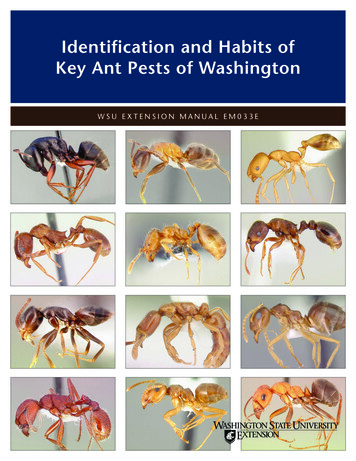
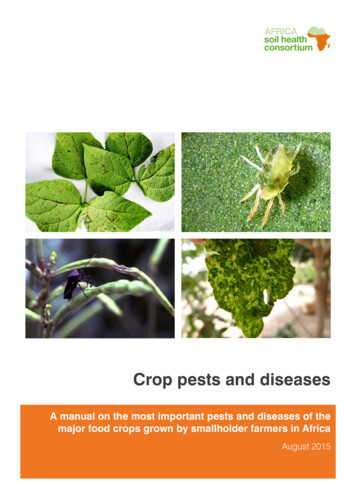
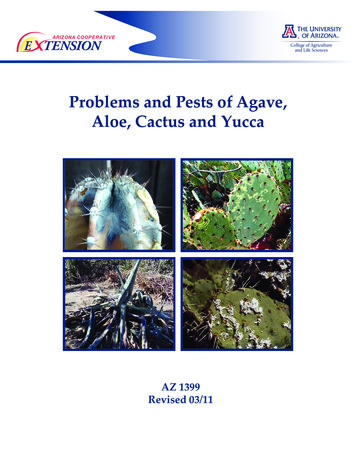
![Fluent Python : [clear, concise, and effective programming]](/img/1/799981060.jpg)
